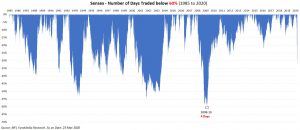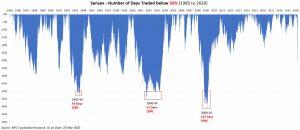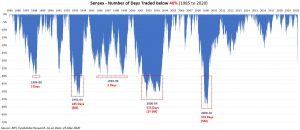In our last article here, we had explained with simple maths, on how the potential future returns from equities at this juncture can be significantly high.
Further, at the current levels (i.e close to 35% decline), valuations have also become very attractive (as measured by Marketcap/GDP, Price to Book and Price to Earnings multiple).
So while this can be a great time to increase your equity allocation, the only problem is, we don’t know whether there can be a further fall and how deep it can go before the eventual recovery.
That leaves us with..
The Second Important Question
How do we invest in equities now as the cash or the debt portion (to be tactically allocated to equities) is a scarce resource and we want to make the most out of it? Should we invest in equities all at once now or stagger it?
This boils down to managing two objectives
- Wanting to look right after 3-5 years
- Not Wanting to look ‘dumb’ for the next 6-12 months
The steep correction in prices, low valuations and earnings growth cycle at its bottom, indicate high chances of looking right after 3-5 years in terms of equity returns.
While objective 1 looks achievable, the real problem comes when we simultaneously want to achieve both 1 and 2!
Not wanting to looking ‘dumb’ for the next 6-12 months means, to wait and deploy the entire amount at the market bottom. Unfortunately we don’t have an answer to how much further decline is left.
Given this constraint, to manage objective 2, we need to take a regret minimization approach. We need to balance between two regrets –
- Entering now only to see your portfolio decline further – Regret of not having waited just a little longer
- Market recovers, it never declines to your expected levels and you completely miss the opportunity to invest – Regret of not having invested earlier and waiting too long
The deployment plan will have to be designed depending on which one will lead to greater regret for you.
Once you decide on the above, we need to make some reasonable assumptions based on past market crashes.
Let us start with the extreme assumption of 60% fall. How likely is that?
Periods with greater than 60% decline from the peak

In the last 40 years, there have been only 4 days where the Sensex went below the 60% fall levels.
You read that right – just 4 days!
Since the odds of such an occurrence is very low, we would not want to wait till a 60% correction happens.
How about a 50% fall. How likely is that?
Periods with greater than 50% decline from the peak

In the last 40 years, there were only 3 bear markets (1992-94, 2000-04 and 2008-10) where the markets fell more than 50% from the previous peak.
Further, whenever this happened, the markets stayed at levels below 50% decline for only 2-4 months.
This means a 50% decline is a very rare occurrence and is usually extremely short-lived (lasted only for 2-4 months). There is also a good chance that these levels are never hit and the markets recover before that.
Given our inherent human tendency to get anchored to the 50% decline level (no idea why), we may keep waiting and miss out on the opportunity to enter equities as usually the recoveries are extremely fast (sample this – in the 2009 recovery, the market (Nifty 500 TRI) went up by 86% in the first 3 months).
The fact that the current fall happened from much lower valuations compared to 2008 – also needs to be kept in mind. The current valuations as measured by MCAP/GDP and Price to Book are already at the 2008 lows. In other words, since the beginning valuations were not as expensive as in 2008, a 35-40% decline will bring today’s markets to similar levels which a 50-60% decline brought to the 2008 markets!
So we would not want to wait till a 50% correction to deploy a majority of our cash.
How about a 40% fall. How likely is this?
Periods with greater than 40% decline from the peak

The longest period for which the markets have stayed at levels below 40% decline is 1 year 5 months.
Excluding the bear market of 2000-04, the longest the markets have stayed at levels below 40% decline is 6 months.
A few days back, the markets were within touching distance of a 40% decline and hence the possibility of the markets touching these levels again cannot be ruled out.
Making sense of the past
So putting all this together, these are our takeaways
- Historically, a decline of 60% has happened only once and lasted for 4 days – this is too rare
- Historically, declines of 50% have been extremely short lived (2-4 months) and very rare
- While you are always tempted to keep waiting for further declines to deploy your cash or a portion of your debt allocation into equities, given the current attractive valuations, a 40-50% decline levels is good enough to deploy a significant portion
- That being said, we also need to factor in the case where the markets may recover even without hitting a 40% decline.
The Plan
So balancing out all these views, here is the plan
- Start a 3 Month to 6 Month Daily STP (based on your personal view on how long you expect this to last) into equity funds with your earmarked money. This ensures that even if your expected lower levels are not hit, you can average out the buying cost at the current levels which are still reasonable in terms of valuation.
- If the market declines sharply, a part of the STP can be converted into lump sum. Ensures aggressive lump sum allocation at lower levels instead of the gradual STP.
1. If Sensex cuts 40% decline levels (~26,000) – Convert STP to lump sum and immediately deploy adequate amount to ensure that 50% of the earmarked money is invested in equities
2. If Sensex cuts 45% decline levels (~24,000) – Convert STP to lump sum and immediately deploy adequate amount to ensure that 75% of the earmarked money is invested in equities
3. If Sensex cuts 50% decline levels (~22,000) – Deploy remaining amount entirely into equities – so that 100% of the earmarked money is now invested in equities
The above plan is just an indicative illustration of our thought process on how to approach the current markets.
Parting Thoughts
Since investing is a very personal endeavor, the above plan needs to be modified based on your own goals, time frame, risk profile and regret thresholds.
The overall idea is to try and strike a balance between your regret of missing out if markets rally from here (optimistic scenario) vs regret of entering too early if markets correct further (middle path scenario).
As Howard Marks brilliantly puts this across in his recent newsletter,
“The more you want to garner potential gains and don’t mind mark-to-market losses, the more you should invest here. On the other hand, the more you care about protecting against interim markdowns and are able to live with missing opportunities for profit, the less you should invest.”
Hope this framework helps you to put in place a plan to handle the current markets.
Stay home, stay safe and stay invested.
This article was originally published on MoneyControl. Click here to read it.







